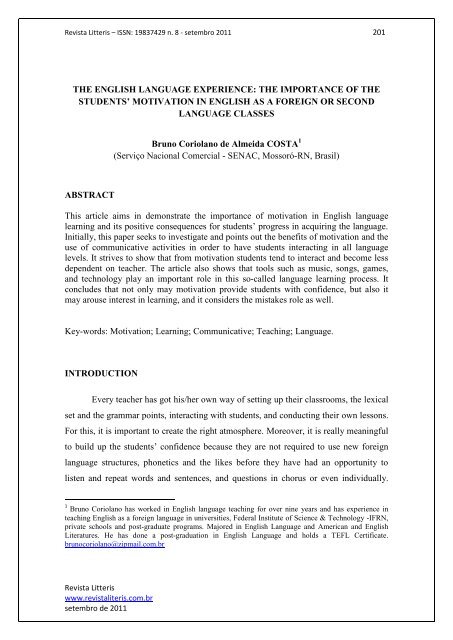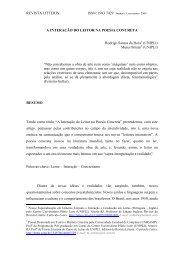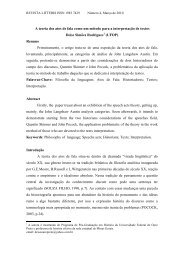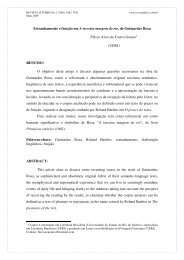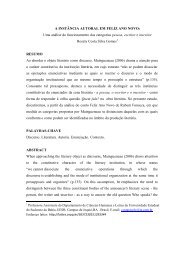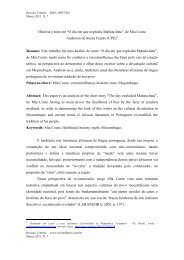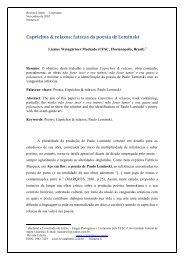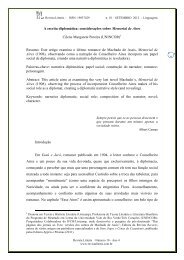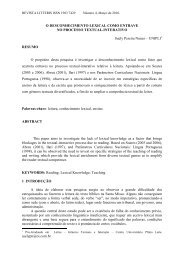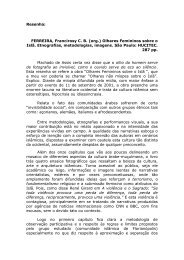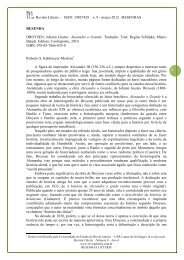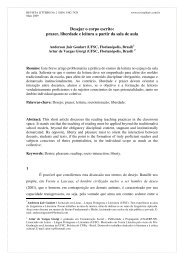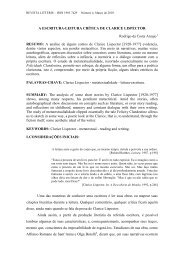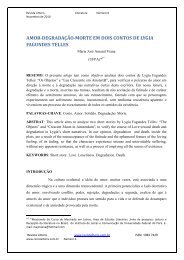THE ENGLISH LANGUAGE EXPERIENCE: THE IMPORTANCE OF ...
THE ENGLISH LANGUAGE EXPERIENCE: THE IMPORTANCE OF ...
THE ENGLISH LANGUAGE EXPERIENCE: THE IMPORTANCE OF ...
You also want an ePaper? Increase the reach of your titles
YUMPU automatically turns print PDFs into web optimized ePapers that Google loves.
Revista Litteris – ISSN: 19837429 n. 8 - setembro 2011 201<br />
<strong>THE</strong> <strong>ENGLISH</strong> <strong>LANGUAGE</strong> <strong>EXPERIENCE</strong>: <strong>THE</strong> <strong>IMPORTANCE</strong> <strong>OF</strong> <strong>THE</strong><br />
STUDENTS’ MOTIVATION IN <strong>ENGLISH</strong> AS A FOREIGN OR SECOND<br />
<strong>LANGUAGE</strong> CLASSES<br />
Bruno Coriolano de Almeida COSTA 1<br />
(Serviço Nacional Comercial - SENAC, Mossoró-RN, Brasil)<br />
ABSTRACT<br />
This article aims in demonstrate the importance of motivation in English language<br />
learning and its positive consequences for students‟ progress in acquiring the language.<br />
Initially, this paper seeks to investigate and points out the benefits of motivation and the<br />
use of communicative activities in order to have students interacting in all language<br />
levels. It strives to show that from motivation students tend to interact and become less<br />
dependent on teacher. The article also shows that tools such as music, songs, games,<br />
and technology play an important role in this so-called language learning process. It<br />
concludes that not only may motivation provide students with confidence, but also it<br />
may arouse interest in learning, and it considers the mistakes role as well.<br />
Key-words: Motivation; Learning; Communicative; Teaching; Language.<br />
INTRODUCTION<br />
Every teacher has got his/her own way of setting up their classrooms, the lexical<br />
set and the grammar points, interacting with students, and conducting their own lessons.<br />
For this, it is important to create the right atmosphere. Moreover, it is really meaningful<br />
to build up the students‟ confidence because they are not required to use new foreign<br />
language structures, phonetics and the likes before they have had an opportunity to<br />
listen and repeat words and sentences, and questions in chorus or even individually.<br />
1 Bruno Coriolano has worked in English language teaching for over nine years and has experience in<br />
teaching English as a foreign language in universities, Federal Institute of Science & Technology -IFRN,<br />
private schools and post-graduate programs. Majored in English Language and American and English<br />
Literatures. He has done a post-graduation in English Language and holds a TEFL Certificate.<br />
brunocoriolano@zipmail.com.br<br />
Revista Litteris<br />
www.revistaliteris.com.br<br />
setembro de 2011
Revista Litteris – ISSN: 19837429 n. 8 - setembro 2011 202<br />
Some advocate that students only start talking when they begin to understand, so<br />
creating the right environment for the classroom is bound to be a fundamental key to<br />
this so-called foreign language learning process.<br />
Teaching is a hard process in which we – as English teachers – have to consider<br />
many different aspects such as students‟ level, background, social context, interests,<br />
purposes, personality, age, learning styles, abilities, and personality characteristics.<br />
About those factors and others, Lightbown and Spada (1997, p. 33) say: “in addition to<br />
personality characteristics, other factors generally considered to be relevant to language<br />
learning are intelligence, aptitude, motivation, and attitudes. Another important factor is<br />
the age at which learning begins”.<br />
Especially in the first levels – beginner and elementary – students might need<br />
more time to think and it is quite normal to have some moments of complete silence in<br />
the classroom while they absorb, process, and practice new information in the language<br />
they are learning. About those levels, Brown (2007, p. 112) says:<br />
At the beginning or even false-beginning level, your students have very little<br />
language “behind” them. You may therefore be tempted to go along with the<br />
popular misconception that the target language cannot be taught directly, that<br />
you will have to resort to a good deal of talking “about” the second language<br />
in the students‟ native language. Such is clearly not the case, as beginning<br />
language courses have demonstrated for many decades. But you do have to<br />
keep in mind that your students‟ capacity for taking in and retaining new<br />
words, structures, and concepts is limited. Foremost on your mind as a<br />
teacher should be the presentation of material in simple segments that don‟t<br />
overwhelm your students.<br />
Yet, in those levels teachers can expect to engage in a lot of repetition of some<br />
limited number of words, expressions, questions, and sentences. Moreover, some<br />
teachers must consider a possibility of some changes in the first days or weeks. Students<br />
of the beginning levels are totally dependent on their teachers, so it is one of the<br />
responsibilities of the teacher to “keep the ball rolling”. Pair work or group work may<br />
be effective ways or techniques to have students working together instead of expecting<br />
much from the teacher. Many educators, especially those at the beginning of their<br />
careers think that the very first levels are challenging and the most difficult ones as well.<br />
Revista Litteris<br />
www.revistaliteris.com.br<br />
setembro de 2011
Revista Litteris – ISSN: 19837429 n. 8 - setembro 2011 203<br />
At the pre-intermediate level, students are sometimes shy and under-confident<br />
about speaking that foreign language in front of the whole class or the peers, and not<br />
surprisingly to the teacher.<br />
At the intermediate levels, students seem more or less use the language in an<br />
effective way because they have already studied most of the elementary grammar rules<br />
and vocabulary. Although, students in this level still make basic mistakes, they are<br />
eager to speak and use the language they already know. About this level, Brown (op.<br />
cit.) points that:<br />
Now, turn your attention to that vague curricular territory that we call<br />
intermediate, where students have progressed beyond novice stages to an<br />
ability to sustain basic communicative tasks, to establish some minimal<br />
fluency, to deal with a few unrehearsed situations, to self-correct on occasion,<br />
to use a few compensatory strategies, and generally to “get along” in the<br />
language beyond mere survival. The picture changes somewhat. Your role<br />
and the student‟s capacities change. (p. 124)<br />
And Last, but not least; Upper-intermediate and advanced students have<br />
experienced and received a lot of inputs and had much contact with the language, but<br />
they still can make some mistakes when trying to speak. Those mistakes are normal,<br />
and as confidence, they play an important role in the whole language learning process.<br />
In this stage teachers change their roles. Now they are supposed to create effective<br />
learning opportunities even within a predominantly learner-centered because the<br />
independence that students have acquired has moved on to another stage in the language<br />
learning. Brown (op. cit.) describes some techniques for those kinds of pupils:<br />
Techniques can now tap into a full range of sociolinguistic and pragmatic<br />
competencies. Typical activities include group debates and argumentation,<br />
and complex role plays. Students also benefit from scanning and skimming<br />
reading material, determining and questioning author‟s intent, and writing<br />
essays and critiques. Often at this level students have specific purposes for<br />
which they are planning to use English. (p.129)<br />
Of course there are many levels in language learning, but not only the whole<br />
class, but also every single learner is a challenge. People learn in different ways. That is,<br />
Revista Litteris<br />
www.revistaliteris.com.br<br />
setembro de 2011
Revista Litteris – ISSN: 19837429 n. 8 - setembro 2011 204<br />
everyone has got his own way of learning languages; his own style – Gardner defines it<br />
as multiple intelligences. The desire to learn can come from many different causes, but<br />
we strongly believe that motivation might help pupils succeed in their language studies.<br />
Quoted by Lightbown and Spada (1997), Gardner (1985) says that “there has been a<br />
great deal of research on the role of attitudes and motivation in second language<br />
learning. The overall findings show that positive attitudes and motivation are related to<br />
success in second language learning”.<br />
According to Abuêndia Padilha (1999), it is of vital importance that teachers<br />
since the very beginning of the learning process of a foreign language should develop a<br />
work with the students that promote confidence to their learning skills focusing on<br />
topics of their interest and by interaction among them. We advocate that in this way,<br />
learners will be able to continue with their learning process in a meaningful way. Not<br />
only can it provide a good language environment, but also motivation.<br />
As an English teacher and based on our experience or not, we know that the<br />
classroom might be the only moment when students can have an exposure to the<br />
English Language. So, students are supposed to make that exposure as rich as they can,<br />
trying to take the risk of speaking in order to learn the language effectively.<br />
This is not a surprise for many of us that teaching and learning is an<br />
unpredictable experience because sometimes students can be dynamic and engaged, but<br />
in some moments during the course, they can feel less enthusiastic about it. Every<br />
student has his/her particular reasons, but almost everyone usually have very busy lives<br />
with their works, studies, or families commitments and attending classes on a regular<br />
way is not always possible. This is one of the most common problems teachers have to<br />
deal with – irregular attendance.<br />
How to solve the irregular attendance problem How to make students feel more<br />
comfortable in the classroom in order to take risk of trying to speak How to motivate<br />
students in English classes Of course the answers for those questions are not so easy<br />
and they will take long analysis and study, but we can say that there are many options<br />
such as making use of the songs in the classroom, dynamics, games, and communicative<br />
activities. According to Harmer (2003, p. 5):<br />
Revista Litteris<br />
www.revistaliteris.com.br<br />
setembro de 2011
Revista Litteris – ISSN: 19837429 n. 8 - setembro 2011 205<br />
The need for surprise and variety within a fifty-minute lesson is also<br />
overwhelming. If, for example, students spend all of that time writing<br />
sentences, they will probably get bored. But if, in that fifty minutes, there are<br />
a number of different tasks with selection of different topics, the students are<br />
much more likely to remain interested. This can be seen most clearly with<br />
children at primary and secondary levels, but even adults need a varied diet to<br />
keep them stimulated.<br />
Many methods, approaches and techniques have been developed along the<br />
decades in order to improve the teaching process. Many teachers have conducted their<br />
classes by following what they consider to be the best way to help students gain<br />
understanding in the subject they are studying and learning. But everything can be a<br />
completely waste of time, if students are not motived or paying any attention to the<br />
lessons. According to Ellis (1985 p. 76):<br />
Motivation is clearly a highly complex phenomenon. These four types of<br />
motivation should be seen as complementary rather than as distinct and<br />
oppositional. Learners can be both integratively and instrumentally motivated<br />
at one and the same time. Motivation can result from learning as well as<br />
cause it. Furthermore, motivation is dynamic in nature; it is not something<br />
that varies from one moment to the next depending on the learning context or<br />
task.<br />
During our experience as an English teacher, we have found out that motivation<br />
is bound to be the key for students‟ understanding. Studies in language teaching have<br />
shown that when students are motivated they take risks in order to learn anything. In<br />
addition, whatever motivation learners seem to have, it is very clear that they are more<br />
likely to do better than the ones without any motivation at all. Those ones who get<br />
interested in something find useful reasons to be engaged in lessons. Harmer (2003, p.<br />
8) has said that:<br />
Famous research carried out in the second half of the twentieth century by<br />
Gardner and Lambert suggested that students who left most warmly about a<br />
language and who wanted to integrate into the culture of its speakers were<br />
more highly motivated (and learnt more successfully) than those who were<br />
only learning language as a means to an end (e.g. getting a job). In other<br />
words integrative motivation was more powerful than Instrumental<br />
Revista Litteris<br />
www.revistaliteris.com.br<br />
setembro de 2011
Revista Litteris – ISSN: 19837429 n. 8 - setembro 2011 206<br />
motivation. But whatever kind of motivation students have, it is clear that<br />
highly motivated students do better than ones without any motivation at all.<br />
Thinking of sharing our classroom experiences and from the literature and the<br />
contact with other teachers, we decided to write some notes about the English teaching<br />
and learning experiences and we will discuss about important topics and suggest that<br />
some communicative activities, songs, and dynamics performed in the classroom are the<br />
best way to help teachers to find and build up learners‟ motivation.<br />
MUSIC AND SONGS IN <strong>LANGUAGE</strong> LEARNING: TOOLS FOR LEARNER‟S<br />
MOTIVATION.<br />
It is known the importance of songs in human‟s lives. In fact, we are in contact<br />
with them all the time. Wherever you are, music and songs are there as well – at school,<br />
gyms, public places, and hospitals. It is not so easy to determine where it comes from,<br />
but men started trying to imitate the sounds of the birds and other animals. It is certain<br />
that people and songs have been living together since the very beginning of the world.<br />
In the classroom, it could not be different. Songs have been used since Plato and<br />
Aristotle. Many philosophers used songs to teach their pupils. This kind of source has<br />
many positive points in English language learning – They automatically put language<br />
into a context, when used, they can give learners very important contact that lends a<br />
natural rhythm to words and phrases, helping language learners to improve their<br />
pronunciation, better comprehension skills, increase vocabulary and speech patterns.<br />
Music aids memory and brings culture alive. Traditional songs and rhymes offer a<br />
wealth of cultural heritage and lots of them are associated with holidays, places, and<br />
times gone by.<br />
Research has shown the positive effects of classical music on the human‟s brain.<br />
In foreign language acquisition, songs are important because of those effects. According<br />
to Murphey (2002) “songs are relaxing. They provide variety and fun, and encourage<br />
harmony within oneself and within a group. Little wonder they are important tools in<br />
sustaining cultures, religions, patriotism, and, yes, even revolutions.” As we know,<br />
when students are having fun, they are more motivated to learn.<br />
Revista Litteris<br />
www.revistaliteris.com.br<br />
setembro de 2011
Revista Litteris – ISSN: 19837429 n. 8 - setembro 2011 207<br />
Researchers have said that pupils need to be motived and relaxed to learn<br />
another language and the writer mentioned in the previous paragraph says:<br />
Many of us have experienced with amazement how quick students are at<br />
learning songs. It is also a common experience to forget nearly everything we<br />
learn in another language except the few songs that we learnt. For a variety of<br />
reasons, songs stick in our minds and become part of us, and lend themselves<br />
easily to exploitation in the classroom. (Murphy, 2002 p. 6)<br />
To sum up, we can say that teachers should consider using music and songs in<br />
their lesson plans. Moreover, we are sure that teachers have those powerful tools which<br />
provide students with a meaningful atmosphere. We argue that using songs in the<br />
classroom will not only help learners to develop their abilities more easily, but also<br />
make them feel confident to study the language. We suggest the book o ensino da<br />
língua inglesa (2001) by Holden and Rogers for those who want further information<br />
about the use of songs in the English language classroom.<br />
DYNAMICS, GAMES AND COMMUNICATIVE ACTIVITIES.<br />
We are sure about the effectiveness of the communicative activities in language<br />
learning. Furthermore, it can be considered one of the best ways to help students to<br />
practice and learn English. But what a communicative activity consist of A<br />
communicative activity is one in which real communication takes place. That is,<br />
communicative activity belongs to a generation of classroom activities used in response<br />
to the need for a more communicative approach in the teaching of second or foreign<br />
languages.<br />
There are many different kinds of activities such as information gap, role-play,<br />
surveys, problem-solving, warmer, lead-in, spot-the-difference, pair-forming activities,<br />
drills, and many other ones. Unfortunately, we do not have space to discuss more about<br />
them in this document.<br />
Those so-called communicative activities play an important role because they<br />
provide students with interaction. That is, those activities help pupils to interact,<br />
negotiate meanings, work in pair or groups, and collaborate to achieve their goals. It is<br />
Revista Litteris<br />
www.revistaliteris.com.br<br />
setembro de 2011
Revista Litteris – ISSN: 19837429 n. 8 - setembro 2011 208<br />
an effective collaborative exchange of experiences, feeling, and ideas. Moreover,<br />
interaction provides students with motivation. Brown (2007, p. 212) puts it in this way:<br />
Interaction is an important word for language teachers. In the era of<br />
communicative language teaching, interaction is, in fact, the heart of<br />
communication; it is what communication is all about. We send messages,<br />
we receive them, we interpret them in a context, we negotiate meanings, and<br />
we collaborate to accomplish certain purposes. And after several decades of<br />
research on teaching and learning languages, we have discovered that the best<br />
way to learn to interact is through interaction itself.<br />
Of course, we have to keep in mind that students go to language school looking<br />
for opportunities to communicate using the language they have chosen to learn. Here,<br />
we are not talking about those tasks where students are expected to repeat a lot of<br />
sentences, questions, and words focusing on a particular part of function or language<br />
structure. In other words, we are not discussing about controlled-practice. Moreover, we<br />
advocate that students should use the language at their command in order to perform<br />
some oral tasks and avoid boredom. About speaking tasks, Harmer (2003, p. 87) says:<br />
Getting students to have a free discussion gives them a chance to rehearse<br />
having discussions outside the classroom. Having them take part in a roleplay<br />
at an airport check-in desk allows them to rehearse such a real-life event<br />
in the safety of the classroom. This is not the same as practice in which more<br />
detailed study takes place; instead it is a way for students to „get the feel‟ of<br />
what communicating in the foreign language really feels like.<br />
There are many possibilities and uses for activities in language courses or<br />
programs. It is known that many photocopiable books were developed to help teachers<br />
to find the most appropriate tasks for each and all levels, but teachers may use their<br />
creativity and adept or create new ones in order to provoke spontaneous communication<br />
in the classroom.<br />
In conclusion, communicative activities, especially in communicative methods,<br />
are doubtless needed. Not only are they helpful and motivating, but also interactive.<br />
Students feel happy and confident when they can communicate among them in a<br />
Revista Litteris<br />
www.revistaliteris.com.br<br />
setembro de 2011
Revista Litteris – ISSN: 19837429 n. 8 - setembro 2011 209<br />
meaningful way. Therefore, communicative activities are a very important tool teachers<br />
should use in order to improve their lessons.<br />
USING TECHNOLOGY IN ELT TO MOTIVATE STUDENTS<br />
We have no doubts that students learn best when they are motivated. Another<br />
way to have students engaged is by including technology in language learning.<br />
Researchers have shown the importance and how technology may help students to get<br />
motivated in order to learn best.<br />
Some might say that technology can bring important benefits into the classroom.<br />
Not only students‟ learning may increase, but also their enthusiasm because students do<br />
not need to be passive recipients of knowledge; they become active participants in the<br />
learning process. The learning environment is positively affected by the use of<br />
technology-based instructional strategies. But how can we use technology in the<br />
classroom in order to have students interacting To answer this question, we should<br />
define technology first.<br />
When we talk about technology we are not only talking about computer, but also<br />
about many things from audiotapes passing throughout CDs, DVDs, overhead<br />
projection to video and, of course, computers.<br />
According to Brown (2007) “when someone mentions technology in the<br />
language classroom, your first impulse is to think computer technology, mostly because<br />
computers have so pervaded our daily home and workplace contexts”. Taking into<br />
account the author‟s thought, we should consider the advantages of the use of those<br />
devices in the classroom such as computer and CDs, for instance.<br />
If your teaching situation allows you to use computers and the likes – computerbased<br />
technology – in the classroom, you are a lucky teacher. But if, and there are some<br />
cases, in your school those tools are not available you may find or use “old” tools such<br />
as realia, other textbooks, visual aids, and students‟ textbooks – non-computer-based<br />
technology. About the self-made paper-based visual aids, Brown (2007, p.193) says:<br />
Revista Litteris<br />
www.revistaliteris.com.br<br />
setembro de 2011<br />
With the dominance of computer media in our world today, you may think<br />
it‟s odd to think about some of the more traditional forms of visual aids.<br />
Posters, charts, and magazine pictures represent “old-fashioned” but effective<br />
teaching aids. If you are artistically inclined, you should consider trying your
Revista Litteris – ISSN: 19837429 n. 8 - setembro 2011 210<br />
hand at creating posters or charts for classroom use. Otherwise, a resource<br />
that many teachers find helpful is an assemblage of a couple of hundred<br />
magazine pictures that you can file and cross-index. Start with a pile of fairly<br />
recent magazines and pick out pictures (photos, diagrams, advertisements,<br />
etc.) that show people or objects large enough to be easily seen by all<br />
students in a classroom setting.<br />
Although many people think in language learning in a very traditional way –<br />
students and the teacher in the classroom – many learners may feel motivated in<br />
learning or reinforcing their studies by themselves at home; that is, many students may<br />
practice the language they are learning by using CDs, DVDs, and CD-ROMs.<br />
Moreover, they can use computer-assisted language learning – CALL whenever they<br />
want, and sometimes, any time they desire, at home, for instance. That is one important<br />
role of the use of technology in language learning.<br />
In fact, the possible uses of technology in the classroom are endless. Teachers<br />
should consider that pupils are used to “virtual life”. Furthermore, emails, sites, blogs,<br />
and the likes are part of the everyday activities students do. Yet, they use this<br />
technology by using English language as well. Brown (2007, p.203) suggest a project<br />
involving web page design where students may feel motivated in order to practice the<br />
language:<br />
An interesting, motivating project for students in a class is to create their own<br />
class web page, complete with stories, interviews, biographies, accounts of<br />
field trips, restaurant reviews, photos, video clips, sound bites, and graphics.<br />
Self-made or collaboratively designed videos also offer students a chance to<br />
“ham it up” and make their own video creations.<br />
In summary, we have no doubts about the importance of technology for the<br />
language classroom. Not only technology provides students with a great deal of<br />
resources, but also it may increase their interests and motivation in order to improve<br />
their progress and performance when speaking the language studied.<br />
Revista Litteris<br />
www.revistaliteris.com.br<br />
setembro de 2011
Revista Litteris – ISSN: 19837429 n. 8 - setembro 2011 211<br />
SOME COMMENTS ABOUT MISTAKES IN ELT<br />
So far we have talked about activities, interaction and motivation. When students<br />
are learning a new or a foreign language, they are subjected to make some mistakes. In<br />
fact, those mistakes are part of the language learning process. Even when we consider<br />
this part of the process, we have to keep in mind that it is important to know how to<br />
expose the “correct” way of speaking by correcting mistakes in a way that keeps<br />
learners motivated, because constant interruption to correct students may destroy the<br />
purpose of some activities. Moreover, it can make learners break their confidence and<br />
fail or simply give up.<br />
Now we face tricky questions – what are the reasons for focusing on students‟<br />
errors Why is it so important To answer such questions, we should take into account<br />
what Ellis (1985, p. 15) states:<br />
At first sight, it may seem rather odd to focus on what learners get wrong<br />
rather than on what they get right. However, there are good reasons for<br />
focusing on errors. First, they are a conspicuous feature of learner language,<br />
raising the important question of „why do learners make errors‟ Second, it<br />
is useful for teachers to know what errors learners make. Third,<br />
paradoxically, it is possible that making errors may actually help learners to<br />
learn when they self-correct errors they make.<br />
Besides focusing on errors, we have to make something clear – the difference<br />
between error and mistake and the way correction should happen so that students will<br />
not feel demotivated. To Ellis (op. cit.):<br />
How can we distinguish errors and mistakes One way might be to check the<br />
consistency of learners‟ performance. If they consistently substitute „contain‟<br />
for „contained‟ this would indicate a lack of knowledge – an error. However,<br />
if they sometimes say „contain‟ and sometimes „contained‟, this would<br />
suggest that they possess knowledge of the correct form and are just slipping<br />
up – a mistake. Another way might be to ask learners to try to correct their<br />
own deviant utterances. Where they are unable to, the deviations are errors;<br />
where they are successful, they are mistakes. (p. 17)<br />
Revista Litteris<br />
www.revistaliteris.com.br<br />
setembro de 2011
Revista Litteris – ISSN: 19837429 n. 8 - setembro 2011 212<br />
Whatever it is – a mistake or an error – if we correct every time students make it,<br />
they will end up not trying to speak English anymore. We are not arguing that there is<br />
no place for correction in the classroom, but that we should consider the proper way of<br />
doing it, whether it is a peer-correction, teacher-correction, or self-correction.<br />
It is known that there are many ways of correcting students‟ mistakes. Not only<br />
teachers should be aware of how to correct, but also do it in a non-obtrusive way.<br />
Learners must know they are expected to take the risk of making mistake or saying<br />
something in a wrong way when practicing the language. Harmer (2003, p. 94) says<br />
that:<br />
As with any kind of correction, it is important not to single students out for<br />
particular criticism. Many teachers deal with the mistakes they heard without<br />
saying who made them. Of course, there are no hard and fast rules about<br />
correcting. Some teachers who have a good relationship with their students<br />
can intervene appropriately during a speaking activity if they do it in a quiet<br />
non-obtrusive way.<br />
In few words, we would say that students do not attend class looking for mistakes; that<br />
is, they do not go to languages schools or programs to make mistakes and come back home<br />
without teacher‟s feedback, but considering mistakes as part of the process and taking into<br />
account that the way we correct them may negatively or positively affect students‟ progress is<br />
doubtless important.<br />
CONCLUSION<br />
Even though every single teacher has his/her own way of performing in the classroom,<br />
after finishing this paper, we have taken into account that in the language teaching/learning one<br />
topic is doubtless significant – motivation.<br />
Although many teachers and teachers‟ trainers know the important role played by<br />
motivation, it is not so easy to keep it during a course on even in just one lesson. In this article,<br />
we have just mentioned some topics about the importance and how to make motivation increase<br />
for the benefit of the whole process of language learning. Not only teachers have many<br />
resources, but also they are easy to find and use them in order to “keep the ball rolling”.<br />
Revista Litteris<br />
www.revistaliteris.com.br<br />
setembro de 2011
Revista Litteris – ISSN: 19837429 n. 8 - setembro 2011 213<br />
And finally, we discussed about the use of songs, dynamics, games, and technology in<br />
order to make the whole process much easier. We conclude by showing that mistakes are very<br />
important elements of this path to the learning of a foreign or second language.<br />
REFERENCES<br />
BROWN, H. D. Teaching by principles: an interactive approach to language<br />
pedagogy. 3rd. Edition. New York: Pearson, 2007.<br />
ELLIS, R. Second language acquisition. Oxford: Oxford University Press.1985.<br />
FIGUEIREDO, Francisco José Quaresma de. Aprendendo com os erros: Uma<br />
perspectiva comunicativa de ensino de Línguas. Goiâna. Editora UFG. 1997.<br />
GARDNER. R. Social Psychology and Second Language Learning: the role of<br />
attitudes and Motivation. London: Edward Arnold. 1985.<br />
HARMER. Jeremy. How to teach English: an introduction to the practice of English<br />
language teaching. Pearson. 2003.<br />
HOLDEN, Suzan & ROGERS, Mickey. O ensino da língua inglesa. São Paulo:<br />
Special Book Services Livraria, 2001.<br />
LIGHTBOWN, P. M.; SPADA, N. Factors affecting second language learning. In. how<br />
languages are learned. Oxford: Oxford University Press, 1997.<br />
MURPHEY, Tim. Music and Song. New York: Oxford University Press, 2002.<br />
NUMAN, David; CARTER, Ronaldo. The Cambridge guide to Teaching English to<br />
Speakers of Other Languages. Cambridge: Cambridge University Press. 2004.<br />
PINTO, Abuêndia P. P. Parâmetros Curriculares Nacional - PCN: Influência no ensinoaprendizagem<br />
de língua estrangeira. In: Elizabeth Marcuschi. (Org.). Formação do<br />
educador, avaliação e currículo. Série Políticas Educacionais em Debate. Recife:<br />
Editora da UFPE, 1999, v. 02, p. 117-132.<br />
RIVERS, Wilga. Interactive Language Teaching. New York: Cambridge University<br />
Press. 1987.<br />
YULE, George. The study of language. New York: Cambridge University Press 1985<br />
Revista Litteris<br />
www.revistaliteris.com.br<br />
setembro de 2011


